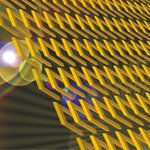Physics

Optical clocks might become the atomic clocks of the future. Their "pendulum", i.e. the regular oscillation process which each clock needs, is an oscillation in the range of the visible light.
As its frequency is higher than that of the microwave oscillations of the cesium atomic clocks, physicists expect another increase in the accuracy, stability and reliability. In the case of one of the candidates for an optical clock which is developed at Physikalisch-Technische Bundesanstalt (PTB), strontium atoms are retained in the interference pattern of two laser beams.
In this so-called "optical…

Ten years ago, astronomers made the stunning discovery that the universe is expanding at a faster pace today than it did in the past.
“Explaining why the expansion of the Universe is currently accelerating is certainly the most fascinating question in modern cosmology,” says Luigi Guzzo, lead author of a paper in this week’s issue of Nature, in which the new results are presented. “We have been able to show that large surveys that measure the positions and velocities of distant galaxies provide us with a new powerful way to solve this mystery.”
“This implies that one of two very different…

Cosmologists at the University of Illinois say ancient light absorbed by neutral hydrogen atoms could be used to test certain predictions of string theory - but they'll need a gigantic array of radio telescopes to do it, somewhere in the neighborhood of 1,000 square kilometers.
String theory is commonly considered (and one of our Ph.D.s will likely point out the flaws in this simplified explanation) a theory in which the fundamental building blocks are tiny one-dimensional filaments. One of its many flavors is usually the leading contender for a 'theory of everything' that unifies all…

An international research team has discovered that a magnetic field can interact with the electrons in a superconductor in ways never before observed.
Andrea D. Bianchi, the lead researcher from the Université de Montréal, explains in the January 11 edition of Science magazine what he discovered in an exceptional compound of metals – a combination of cobalt, indium and a rare earth – that loses its resistance when cooled to just a couple of degrees above absolute zero.
“When subjected to intense magnetic fields, these materials produce a completely new type of magnetic tornado that grows…

For the past 40 years, light-emitting diodes have been successfully employed wherever small amounts of light are needed. Present-day applications include car indicators, reversing and brake lights. However, the efficiency and luminosity of LEDs have never yet been sufficient to achieve a major breakthrough.
Thanks to new technologies for chip manufacturing, structural design and beam shaping developed by scientists at OSRAM Opto Semiconductors the light output of LEDs has been vastly improved. In Berlin on December 6, President Horst Köhler presented the team of OSRAM and Fraunhofer…
As structures made of metal get smaller — as their dimensions approach the micrometer scale (millionths of a meter) or less — they get stronger. Scientists discovered this phenomenon 50 years ago while measuring the strength of tin "whiskers" a few micrometers in diameter and a few millimeters in length. Many theories have been proposed to explain why smaller is stronger, but only recently has it become possible to see and record what's actually happening in tiny structures under stress.
Andrew Minor, of the Materials Sciences Division in the Department of Energy's Lawrence Berkeley National…

As electronics designers cram more and more components onto each chip, current technologies for making random-access memory (RAM) are running out of room. European researchers have a strong position in a new technology known as resistive RAM (RRAM) that could soon be replacing flash RAM in USB drives and other portable gadgets.
On the ‘semiconductor road map’ setting out the future of the microchip industry, current memory technologies are nearing the end of the road. Future computers and electronic gadgets will need memory chips that are smaller, faster and cheaper than those of today –and…

In the world of commercial materials, lighter and cheaper is better - especially when coupled with superior strength and special properties such as a material's ability to remember its original shape after it's been deformed by a physical or magnetic force.
A new class of materials known as "magnetic shape-memory foams" has been developed by two research teams headed by Peter Müllner at Boise State University and David Dunand at Northwestern University.
The foam consists of a nickel-manganese-gallium alloy whose structure resembles a piece of Swiss cheese with small voids of space between…

Researchers stunned the world when they announced a cloaking device for the microwave range. This device made use of metamaterials that had a negative refractive index for electromagnetic radiation. The metamaterials were carefully designed split-ring resonators with a structure size much smaller than the wavelength. Only 10 stacked layers of metamaterials were necessary to achieve the desired invisibility effect.
Now, researchers from the group of Harald Giessen at the University of Stuttgart have succeeded in manufacturing a stacked split-ring metamaterial for the optical wavelength range (…

If you do a search here on the LHC, you find all kinds of news articles.
The LHC was completed in April, except it wasn't, and parts broke, or were still being designed and testing will be delayed, except it's unimportant and it will still be the greatest thing ever. Maybe it will be. Or it will be another Hubble.
After yesterday's statements by CERN Director General Robert Aymar it's still unclear when it will be done or how it will work but, he says, 'good progress has been made on all fronts.'
So here's the latest:
The LHC is now fully installed in its 27 km tunnel. The second of the two…